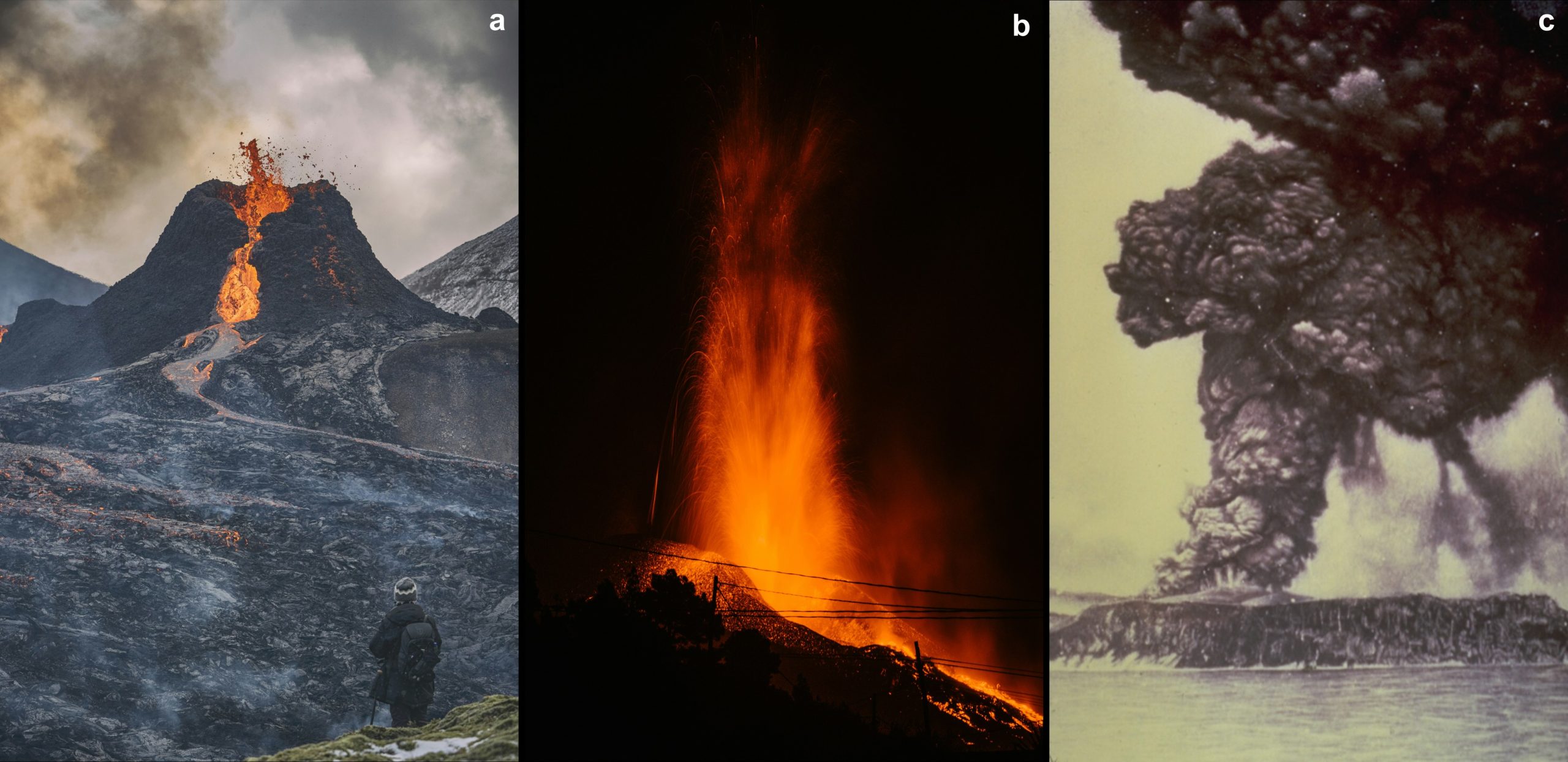How is the size of an eruption measured?
To understand how a volcanic eruption is measured, we must go back to 1982… when the scientists Chris Newhall and Stephen Self developed the Volcanic Explosivity Index (VEI) to determine the size of eruptions. The problem volcanologists faced at that time was clear: unlike other sciences, such as seismology, which has instruments to accurately measure the magnitude of earthquakes, volcanology lacked any tool capable of determining the magnitude of volcanic eruptions.
You might wonder: how is the VEI calculated? Eruptions are assigned a VEI according to a logarithmic scale ranging from 0 to 8. A value of 0 corresponds to non-explosive eruptions, and from 2 onward, each increment of 1 represents an eruption that is 10 times more explosive! (Figure 1).

Figure 1. a. Eruption of Fagradalsfjall Volcano (Iceland) in 2021, VEI 0; https://unsplash.com/. b. Eruption of Tajogaite Volcano (Spain) in 2021, VEI 3; https://unsplash.com/. c. Eruption of Krakatoa Volcano (Indonesia) in 1883, VEI 6; photograph courtesy of the family of R. Breon, published in Simkin and Fiske (1983), Global Volcanism Program, Smithsonian Institution https://volcano.si.edu.
Although the scale has no maximum value, the largest known eruptions have a VEI of 8. The calculation takes into account several parameters, such as the volume of pyroclasts ejected, the height reached by the eruptive column, and the duration of the eruption (Table 1).

Table 1. Criteria for estimating the Volcanic Explosivity Index (VEI), modified from Newhall and Self (1982). The criteria are listed in decreasing order of reliability.
Now that we know how the size of an eruption is measured, and before wrapping up this blog, let’s discuss some of the limitations of the VEI. Measuring the volume of pyroclastic material emitted is not always an easy task, as this material is often easily eroded and dispersed across vast stretches of both emerged and submerged terrain (lakes, seas, and oceans). Furthermore, until the eruption ends— which can sometimes take years!— it is not possible to determine the total volume of pyroclasts ejected and, therefore, to accurately estimate the VEI. However, it is possible to make estimates for the most significant phases. These limitations, however, should not detract from the value of the VEI, which remains a highly valuable tool for estimating the magnitude of eruptions and comparing them to one another.
If you are curious about the VEI of a specific eruption or want to explore the characteristics of different active volcanoes around the world, we recommend visiting this page: https://volcano.si.edu/volcanolist_holocene.cfm. It’s full of information, photographs, and resources to help you keep learning!
References
Newhall, C.G., Self, S., 1982. The volcanic explosivity index (VEI) an estimate of explosive magnitude for historical volcanism. J. Geophys. Res. Oceans 87(C2), 1231-1238. https://doi.org/10.1029/JC087iC02p01231
If you want to cite this entry from the volkiblog:
Prieto-Torrell, C., Geyer, A., & Schamuells, N. (2025). ¿CÓMO SE MIDE EL TAMAÑO DE UNA ERUPCIÓN?. Zenodo. https://doi.org/10.5281/zenodo.14600630
Texts: Claudia Prieto-Torrell (GEO3BCN-CSIC), Adelina Geyer (GEO3BCN-CSIC)
Illustrations: Noah Schamuells (GEO3BCN-CSIC)
Terms of use: This document is published under a CC By-NC-ND (Creative Commons Attribution-NonComercial-NoDerivates) license. Downloading and sharing is allowed freely as long as proper credit is given. It may not be changed in any way or used commercially. For more information about the CC By-NC-ND click here.
